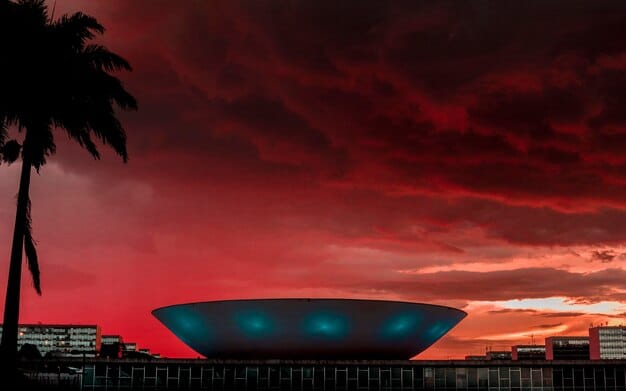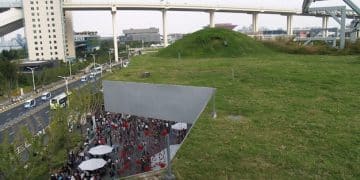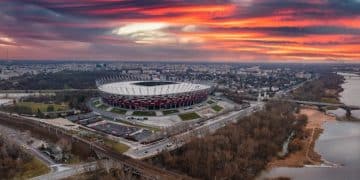World Cup 2026: Economic Impact on US Host Cities – Detailed Analysis

The 2026 FIFA World Cup is poised to deliver a significant economic boost to its US host cities, with projected impacts spanning tourism, job creation, infrastructure development, and sustained economic activity, far beyond the tournament’s final whistle.
The anticipation for the
World Cup 2026: The Economic Impact on US Host Cities – A Detailed Analysis
continues to build, especially given its unprecedented scale across three North American nations. For the US host cities, this event is more than just a series of soccer matches; it represents a monumental economic opportunity. Understanding the potential financial currents stirred by such a colossal sporting spectacle is crucial for residents, businesses, and policymakers alike.
The economic blueprint of mega-events
Mega-sporting events, like the FIFA World Cup, are often viewed as catalysts for economic growth and urban transformation. Cities bid aggressively to host these spectacles, not just for the prestige or the global spotlight, but for the tangible and intangible benefits they are expected to deliver. These benefits extend from immediate financial inflows to long-term infrastructural improvements and enhanced global recognition.
The economic blueprint typically involves several key components. The most direct impact comes from visitor spending, encompassing everything from hotel nights and restaurant meals to merchandise and local transportation. This influx of tourism dollars creates a ripple effect throughout the local economy, supporting small businesses and generating tax revenues. Beyond tourism, there’s the significant investment in infrastructure, including stadium upgrades, transportation networks, and public safety enhancements, which can have lasting positive effects on urban quality of life.
Direct and indirect economic benefits
The economic impact of the World Cup can be categorized into direct and indirect benefits. Direct benefits are immediate and quantifiable, such as spending by fans, teams, media, and FIFA officials. This spending directly boosts sectors like hospitality, retail, and transportation. Indirect benefits, however, are more pervasive, affecting a broader range of industries and extending over a longer period.
- 📈 Induced economic output: New business generated from increased demand in various sectors.
- 📊 Job creation: Temporary and permanent jobs across diverse industries.
- 🏗️ Infrastructure investment: Upgrades to stadiums, transport, and public facilities.
- 💡 Enhanced city branding: Increased global visibility attracting future tourism and investment.
The challenge for host cities lies in maximizing these benefits while mitigating potential drawbacks, such as increased cost of living for residents or the risk of white elephant stadiums. Careful planning and robust public-private partnerships are essential to turning the economic blueprint into a successful reality for all stakeholders.
Furthermore, the World Cup often acts as a significant marketing tool for host cities. The global television audience offers an unparalleled opportunity to showcase a city’s attractions, culture, and business environment. This exposure can translate into increased post-tournament tourism and foreign investment, contributing to a longer-term economic legacy that extends well beyond the final whistle.
Tourism and hospitality boom
For US host cities, the World Cup 2026 presents an unparalleled opportunity to witness a massive surge in tourism and hospitality. The tournament’s global appeal ensures millions of fans will travel, not just from abroad but also domestically, to experience the matches firsthand. This influx of visitors will directly translate into a significant boost for local economies, particularly in the hotel, food service, and entertainment sectors.
Hotel occupancy rates are expected to skyrocket, with premium pricing during the tournament dates. Restaurants, bars, and retail establishments will see increased foot traffic and spending. Beyond direct expenditures on lodging and dining, visitors will also spend on local transportation, attractions, and souvenirs, further stimulating local commerce. Many small businesses, from independent coffee shops to boutique stores, stand to benefit from this expanded customer base.
Accommodation demands and revenue generation
The demand for accommodation will be immense, stretching from luxury hotels to budget-friendly options and short-term rentals. This surge in demand creates a substantial revenue stream for the hospitality industry and, by extension, generates significant tax revenue for host cities. Local governments often levy hotel occupancy taxes, which can be channeled back into public services or further infrastructure development.
- 🏨 Hotels: Full occupancy and higher average daily rates.
- 🏡 Short-term rentals: Increased bookings for platforms like Airbnb.
- 🏬 Retail: Boost in sales of merchandise and local products.
- 🍽️ Food & Beverage: Restaurants and bars experience peak demand.
A crucial aspect of managing this tourism boom will be ensuring adequate capacity and seamless visitor experience. Cities will need to coordinate public transportation, regulate pricing to prevent price gouging, and enhance public safety measures to accommodate the millions of incoming fans. The goal is not just to maximize immediate revenue but also to ensure a positive experience that encourages repeat visitation in the future.
The long-term impact of this tourism surge cannot be overstated. Successful hosting can elevate a city’s international profile, positioning it as a desirable destination for future travel and major events. The positive experiences of World Cup attendees can generate word-of-mouth marketing, attracting new tourists for years to come, long after the stadiums have emptied.
Job creation and labor market impacts
A significant aspect of the World Cup’s economic impact on US host cities is its potential to generate substantial employment, both temporary and permanent. Preparing for and executing an event of this magnitude requires a vast workforce across numerous sectors. This includes jobs directly related to event operations, as well as those created indirectly by increased economic activity.
In the immediate run-up to the tournament and during the event itself, there will be a surge in demand for positions in event management, security, transportation, hospitality, and construction. Stadium staff, hospitality workers, volunteers, and logistics personnel will be among the thousands hired to ensure smooth operations. Beyond these direct roles, businesses benefiting from the increased tourism, such as restaurants, retail stores, and local attractions, will likely expand their staff to meet the elevated demand.

Diverse employment opportunities
The types of jobs created are incredibly diverse, catering to a wide range of skill sets. From entry-level positions to specialized roles, the World Cup provides opportunities for various segments of the labor force. This includes part-time and full-time roles, offering both short-term income opportunities and, in some cases, pathways to more permanent employment.
- 👷 Construction: Stadium renovations, infrastructure upgrades.
- 🏨 Hospitality: Hotel staff, restaurant workers, caterers.
- 🚨 Security & Public Safety: Event security, police support.
- 🚌 Transportation: Drivers, public transport operators.
While many of these jobs will be temporary, helping to alleviate seasonal unemployment or provide supplementary income, some may transition into permanent roles, particularly if the economic boost leads to sustained growth in specific sectors. Furthermore, the experience gained by those working during the World Cup can be invaluable for their future careers, enhancing their résumés and skill sets.
Cities will also need to consider workforce development programs to ensure local residents are prepared to fill these new roles. Partnerships with community colleges and vocational schools can help train individuals for positions in high-demand areas, ensuring that the economic benefits of job creation are distributed broadly within the local population.
Infrastructure development and urban legacy
Hosting the World Cup 2026 necessitates considerable investment in infrastructure, which can leave a lasting urban legacy for US host cities. Beyond the direct impact of the tournament, these investments often spur long-term improvements in public transport, city beautification, and venue modernization, benefiting residents and businesses for years to come.
Many host cities will undertake significant upgrades to their stadiums, ensuring they meet FIFA’s stringent requirements for capacity, facilities, and technology. These renovations often include enhanced seating, improved connectivity, and new hospitality areas, making the venues more versatile for future events. However, the infrastructure development extends far beyond the stadiums themselves.
Transportation network enhancements
One of the most critical areas of investment will be in transportation infrastructure. Moving millions of fans efficiently and safely requires robust public transit systems, improved road networks, and enhanced airport accessibility. Cities may accelerate projects that were already planned or initiate new ones to meet the demands of the World Cup.
- 🚄 Public transit: Expansion of metro lines, bus services.
- 🚗 Road networks: Upgrades to highways, traffic management systems.
- ✈️ Airport capacity: Terminal expansions, improved baggage handling.
- 🚶 Pedestrian zones: Development of walkable areas around venues.
These transportation improvements can significantly enhance the daily lives of city residents, reducing commute times, improving accessibility, and supporting local businesses. They represent a tangible and enduring benefit, distinguishing the World Cup’s impact from that of events with less focus on legacy infrastructure.
Beyond transportation, host cities often invest in public spaces, parks, and urban beautification projects to enhance the visitor experience and leave a positive impression. These efforts can revitalize neighborhoods, improve quality of life for residents, and promote sustainable urban development, contributing to a lasting positive image and functionality for the city.
Long-term economic impacts and challenges
While the immediate economic benefits of hosting the World Cup are often clear, understanding the long-term economic impacts and potential challenges is crucial for a comprehensive analysis. A successful tournament can, indeed, deliver sustained benefits, but cities must also navigate potential pitfalls to ensure a positive and equitable legacy.
One of the key long-term benefits can be the enhancement of a city’s global brand and reputation. The extensive media coverage and real-time social media exposure during the World Cup can significantly boost a city’s profile on the international stage. This increased visibility can lead to sustained growth in tourism, attract foreign direct investment, and even encourage businesses to relocate, drawn by the enhanced infrastructure and global recognition.
Sustaining momentum and mitigating risks
However, sustaining this momentum beyond the tournament requires strategic planning. Cities need to leverage the new infrastructure, enhanced global image, and increased visitor numbers to foster continued economic development. This involves proactive marketing campaigns, conversion of temporary jobs into permanent ones, and ensuring that the newly built or upgraded facilities remain economically viable long-term.
- 📈 Post-event tourism: Sustained increase in visitor numbers.
- 💰 Foreign investment: Attraction of new capital and businesses.
- 🏙️ Urban regeneration: Continued development in host neighborhoods.
- ⚖️ Resource allocation: Balancing event costs with long-term public needs.
There are also potential challenges. The significant financial outlay for hosting, including infrastructure development and security, can strain public budgets. There’s a risk of “white elephant” venues if stadiums aren’t repurposed effectively after the event. Additionally, an unexpected increase in the cost of living for residents during the tournament—due to higher prices for accommodation and services—can create social pressures if not managed properly.
Careful financial planning, transparent reporting, and community engagement are paramount to ensuring the World Cup’s economic legacy is genuinely positive and inclusive. By addressing these challenges head-on, US host cities can maximize the long-term benefits and solidify their positions as global destinations.
Case studies: Learning from past World Cups
Examining past World Cups offers valuable insights into the potential economic impacts and challenges that US host cities might face in 2026. While each tournament has its unique context, common themes emerge regarding economic boosts, infrastructure legacies, and the importance of strategic planning.
The 1994 World Cup, hosted by the USA, provides a domestic benchmark. That tournament, despite being held primarily in existing NFL stadiums, generated significant ticket sales and tourism revenue. It helped to popularize soccer in the US and demonstrated the country’s capacity to host large-scale global sporting events. The economic benefits were notable, particularly for the host cities, though direct infrastructure spending was less pronounced compared to tournaments elsewhere.

Global examples and varying outcomes
Looking internationally, the 2014 World Cup in Brazil and the 2010 World Cup in South Africa offer more complex case studies. Both countries invested heavily in new stadiums and infrastructure. While substantial economic activity was generated during the event, questions arose about the long-term utility of some of the newly built stadiums and the equitable distribution of economic benefits within the host populations.
- 🇧🇷 Brazil 2014: High investment, mixed long-term stadium usage.
- 🇿🇦 South Africa 2010: Boosted tourism initially, challenges in maintaining stadium viability.
- 🇩🇪 Germany 2006: Leveraged existing infrastructure, strong fan engagement and positive economic outcome.
- 🇰🇷🇯🇵 Korea/Japan 2002: Significant focus on joint hosting, infrastructure upgrades with lasting benefits.
Germany’s 2006 World Cup is often cited as a success story, largely due to its efficient use of existing, high-quality infrastructure and strong local engagement. The event focused on creating a positive atmosphere for fans, which translated into significant spending and a substantial boost to the local economies, with minimal “white elephant” issues.
These case studies underscore the importance for 2026 US host cities to prioritize projects with lasting utility, engage local communities, and ensure transparency in financial planning. The goal is to avoid the pitfalls of overspending on temporary facilities and to ensure that the economic benefits are broadly distributed, creating a truly positive and sustainable legacy.
| Key Aspect | Brief Description |
|---|---|
| 💸 Economic Boost | Massive influx of tourist spending, boosting local businesses. |
| 💼 Job Creation | Thousands of temporary and permanent roles across various sectors. |
| 🛣️ Infrastructure Legacy | Sustainable upgrades to transport and public facilities. |
| ✨ Global Exposure | Enhanced city branding attracting future tourism and investment. |
Frequently asked questions about the World Cup 2026 economic impact
Local businesses in US host cities are expected to experience a significant boom. This includes restaurants, hotels, retail stores, and transportation services due to the massive influx of international and domestic tourists. Many small and medium-sized enterprises will benefit from increased consumer spending and demand for various services during the tournament period.
The World Cup 2026 will create thousands of jobs, both temporary and potentially permanent. These roles will span various sectors, including hospitality (hotels, food services), security, transportation, event management, and construction for stadium and infrastructure upgrades. Opportunities will range from entry-level positions to specialized roles requiring significant expertise.
Yes, the infrastructure investments related to the World Cup 2026 are anticipated to have a lasting impact. Upgrades to stadiums, public transportation networks, airports, and urban public spaces will benefit residents and businesses long after the tournament concludes. These improvements can enhance urban mobility, quality of life, and economic efficiency for years to come.
Host cities can measure economic success through various metrics, including direct visitor spending, job creation figures, tax revenues generated, post-event tourism rates, and long-term inward investment. The effectiveness of infrastructure use and the equitable distribution of economic benefits across the community are also crucial indicators of a successful and sustainable legacy.
Potential challenges include managing the significant financial costs of hosting, ensuring long-term viability of renovated stadiums (“white elephants”), mitigating potential increases in the cost of living for local residents, and effectively distributing the economic benefits to all segments of the population. Careful planning and transparent management are essential to overcome these hurdles.
Conclusion
The 2026 FIFA World Cup stands as a monumental economic opportunity for its US host cities. Far beyond the cheers and drama of the matches, the tournament is poised to unleash a cascade of financial benefits, from a booming tourism and hospitality sector to significant job creation and lasting infrastructure development. While challenges inevitably accompany an event of this scale, the blueprint for success lies in strategic planning, community engagement, and a focus on sustainable legacies. By carefully navigating these currents, US cities can ensure the World Cup leaves an enduring positive mark, solidifying their positions as global destinations and fostering long-term prosperity. The detailed analysis reinforces that this spectacle is much more than just a game; it’s a profound economic catalyst.





